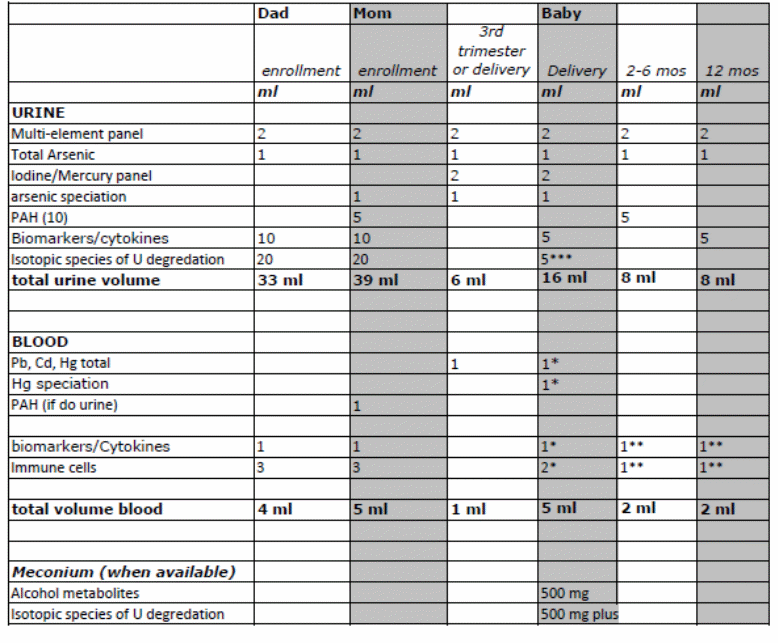Biomonitoring Table
Att15 BiomonitTable&Just.docx
Prospective Birth Cohort Study Involving Environmental Uranium Exposure in the Navajo Nation
Biomonitoring Table
OMB: 0923-0046
Attachment 15: Biomonitoring Table –Testing Times and Analytes*
***
**


*Analyte testing is dependent on funding; All analytes may not be tested if funding is not available
**Multi-element panel includes: uranium, antimony, barium, beryllium, cadmium, cesium, cobalt, lead, molybdenum, platinum, titanium, tungsten
*** Mercury, lead, cadmium panel also includes manganese and selenium
Attachment 14 continued: Justification for Analytes in Exposure Assessment
ANALYTE (S)
|
MATRIX |
JUSTIFICATION |
Uranium |
Urine |
Primary exposure of interest; Levels of urinary uranium reflect recent and accumulated exposure. This exposure metric as well as information obtained from surveys (occupational history, water sources, proximity to uranium mine or mill site) and environmental home assessments will help to give an overall understanding of participants’ current and past exposures to uranium. Uranium has been associated with adverse reproductive, birth, and renal outcomes. |
Antimony |
Urine |
Included in analysis panel with uranium (primary exposure of interest) |
Barium |
Urine |
Included in analysis panel with uranium (primary exposure of interest) |
Beryllium |
Urine |
Included in analysis panel with uranium (primary exposure of interest) |
Cadmium
|
Urine Blood |
Included in analysis panel with uranium (primary exposure of interest). Cadmium has also been associated with lower birth weight, hypertension, and diabetes. Pre-eclampsia and gestational diabetes are conditions that may affect the health outcome of the infant. Cadmium is a frequent component in “silver solder” used in in-home jewelry making .It is not found to be present in concentrations of concern in mine wastes. Based on results from the 2008 CDC Water Hauling Study, cadmium has been found in unregulated water sources.
|
Cesium |
Urine
|
Included in analysis panel with uranium (primary exposure of interest) |
Cobalt |
Urine |
Included in analysis panel with uranium (primary exposure of interest) |
Lead |
Urine
Blood
|
Included in urine analysis panel with uranium. Lead is an important confounder. High lead exposures have been associated with developmental delays and lower IQ in children
|
Molybdenum |
Urine |
Included in analysis panel with uranium (primary exposure of interest) |
Platinum |
Urine |
Included in analysis panel with uranium (primary exposure of interest) |
Titanium |
Urine |
Included in analysis panel with uranium (primary exposure of interest) |
Tungsten |
Urine |
Included in analysis panel with uranium (primary exposure of interest) |
Mercury
|
Blood |
Coal-fired power plants located in Navajo Nation may contribute to potential mercury exposure. Elevated mercury levels have been associated with developmental delays in children |
Manganese |
Blood |
Included in analysis panel with mercury (strong confounder with uranium); High prenatal manganese in mothers has been linked to behavioral problems in their children
|
Selenium |
Blood |
Included in analysis panel with mercury (strong confounder with uranium); Component of prenatal vitamins; Selenium deficiency has been associated with adverse birth outcomes
|
Arsenic
|
Urine |
Arsenic MCL was exceeded in unregulated water sources tested by CDC. Arsenic has also been associated with developmental delays and birth defects
|
Biomarkers/cytokines |
Urine |
Biomarkers/cytokine testing will help to understand immunological and kidney dysfunction in participants which may be associated with adverse outcomes in their children
|
Isotopic species of U degradation |
Urine |
Uranium decay produces a series of isotopes which are primarily alpha and beta emitters, although some gamma emissions continue to be associated with decay. When used in home construction, these radioactive elements can contribute to chronic radiation exposures
|
Fetal Alcohol metabolites |
Meconium |
Community members and health care workers have suggested that alcohol consumption will continue through pregnancy among some individuals.; Alcohol consumption during pregnancy has been associated with adverse birth outcomes
|
PAHs |
Blood |
Previous studies by the Diné Network for Environmental Health (DiNEH) project have reported that some Navajo tribal members cook their food directly over open flames inside the home. Therefore, there is a potential for PAH exposure through inhalation and ingestion. PAHs have been linked to neural tube defects in children
|
Immune cells |
Immune cells |
The results of the biomarker analysis from the DiNEH Project indicated a relationship among the proximity surrogate for exposures, changes in cytokines such as IL-4, and changes in immune cell type percentages suggesting hyper reactivation and dysfunction in the immune system.; Immune dysfunction may have an adverse effect on babies
|
| File Type | application/vnd.openxmlformats-officedocument.wordprocessingml.document |
| Author | Davis, Stephanie I. (ATSDR/DHS/HIBR) |
| File Modified | 0000-00-00 |
| File Created | 2021-01-24 |
© 2025 OMB.report | Privacy Policy